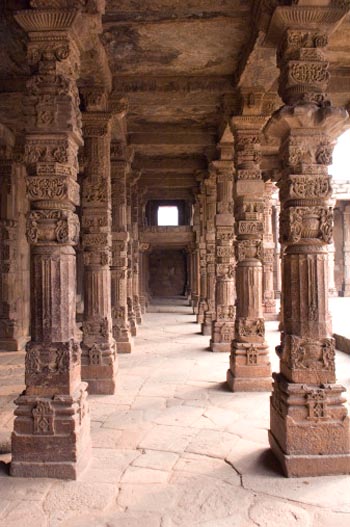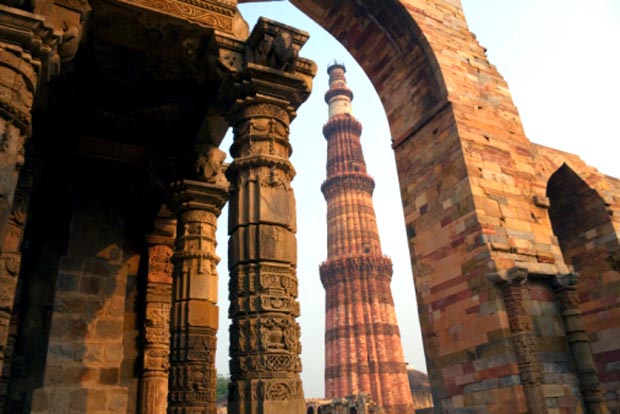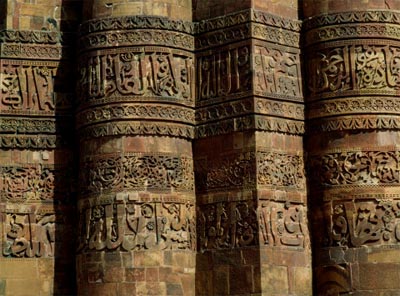Dec 31, 2025
Dec 31, 2025
In 1192, fresh from his victory over the brave but futile resistance of the Rajputs1, Muhammed Ghori left as his viceroy in Delhi Qutb-ud-Din Aibak, who was to become the first Sultan in the Slave Dynasty.2 After the death of Ghori, Qutb-ud-Din lost no time in declaring himself the ruler and embarked upon a vigorous campaign to quell dissidence, both in his home cities in Afghanistan as well as in and around Delhi. Recognizing the strategic value of the city, Qutb-ud-Din is credited with being the first to realize that 'he who holds Delhi rules India'.3
There were two ways of consolidating power - militarily and theocratically. Once the immediate military aims were achieved, Qutb-ud-Din set about to establish himself not just as a marauding invader, but a proselytizing missionary.
The Quwwatu'l Islam
The first mosque in India, the Quwwatu'l Islam (The Might of Islam) was constructed by destroying, in Qutb-ud-Din's own words, 27 Hindu and Jain temples in the region. The mosque originally consisted of a rectangular court 43.2 m by 33 m, enclosed by colonnaded cloisters. This enclosure formed the heart of the mosque, delineating a space where the faithful could kneel to pray.
 It is with a closer examination of the columns that the otherwise undistinguished mosque begins to assume significance. Dismantled from temples, the columns still betray a riot of carving - human forms, gods and goddesses, flora and fauna, jewelry and other motifs - which was characteristically Hindu, but was expressly forbidden in Islamic architectural expression.4 The shortage of both time and money forced the Muslim ruler to reuse inherently sacrilegious elements.
It is with a closer examination of the columns that the otherwise undistinguished mosque begins to assume significance. Dismantled from temples, the columns still betray a riot of carving - human forms, gods and goddesses, flora and fauna, jewelry and other motifs - which was characteristically Hindu, but was expressly forbidden in Islamic architectural expression.4 The shortage of both time and money forced the Muslim ruler to reuse inherently sacrilegious elements.
A compromise was effected by knocking off the faces of the deities and other human and animal forms. The result is a curious combination - a structure which is architectonically a mosque with apparently vandalized Hindu components. The riot of defaced carving is complemented with the difference in the columns - they came from not one, but several demolished temples. Above the cloisters rise imperfect corbelled domes - the result of Hindu craftsmen striving to erect a form of which they had no prior experience.
With the cloisters complete, it was time to define the qibla or the axis along which lay Mecca. This was done by erecting a stone screen of five arches, the central one the highest at 16 m, flanked on each side by two smaller ones. Ogee-shaped, the arches are again imperfect as they are made by corbelling stone rather than by wedge-shaped voussoirs. Carved in alternating bands of inscriptions and arabesque ornamentation, the hand of the Hindu craftsman is again evident in the sinuous carving as well as serpentine, floral motifs which sneak in every so often.
This mosque was later extended and enlarged by two subsequent rulers, Iltutmish and Ala-ud-Din Khilji, who between them nearly quadrupled the size of the original enclosure.
The Qutb Minar
The mosque and its ancillaries finished, Qutb-ud-Din laid the foundation of the world-famous Qutb Minar. Intended to serve a double function - both as a minaret for the mosque as well as the most visible symbol of his growing power, the Qutb with a height of 72.5 m is the highest stone tower in the world.

Repaired and added to numerous times by successive rulers, the Qutb today consists of five storeys, each distinct. The lowest has alternately circular and triangular fluting, the second circular, the third triangular, while the fourth and fifth are mostly plain. Each storey is articulated by a balcony, projecting on a system of stalactite pendentives - this feature appearing for the first time in India and no doubt imported from classical Islamic construction.
 The Qutb and its associated structures today is the most visible and famous landmark of Delhi, at par with Taj Mahal. Thousands of tourists, both Indian and foreign, swarming the site each day testify to its appeal. However, perhaps more important, in the evolution of the history of Indian architecture, it holds a unique place. This was the first time that Hindu craftsmen and Muslim builders allied together. It could be asserted that the result was forms and details confused and hesitant, structurally incompetent and formally subject to a myriad of influences. Yet at no time does the Qutb complex lose its magnificence, and we see in this first stumbling step the beginnings of a long association between the two contrary cultures of Islam and Hinduism. This was to result in an architecture which was undoubtedly Islamic but distinctly sub-continental - a true fusion between Muslim sensibilities and Hindu capabilities.
The Qutb and its associated structures today is the most visible and famous landmark of Delhi, at par with Taj Mahal. Thousands of tourists, both Indian and foreign, swarming the site each day testify to its appeal. However, perhaps more important, in the evolution of the history of Indian architecture, it holds a unique place. This was the first time that Hindu craftsmen and Muslim builders allied together. It could be asserted that the result was forms and details confused and hesitant, structurally incompetent and formally subject to a myriad of influences. Yet at no time does the Qutb complex lose its magnificence, and we see in this first stumbling step the beginnings of a long association between the two contrary cultures of Islam and Hinduism. This was to result in an architecture which was undoubtedly Islamic but distinctly sub-continental - a true fusion between Muslim sensibilities and Hindu capabilities.
And ever in the future, there was the Qutb, a lofty symbol of God's will, enclosing between itself and its counterpart5 the 'entire paradise of God's world'.6
Images under license with Gettyimages.com
1. This was the famous battle against Prithviraj Chauhan, the apparently magnanimous ruler of Delhi, who had defeated Ghori twice earlier, but in a display of incredible ignorance, let him go free each time.
2. The word 'slave' here has no demeaning connotations as capable servants were highly valued and often rose to positions of great responsibility, especially in military service.
3. Brown, Percy Indian Architecture (Islamic Period) D.B. Taraporevala Sons and Co. Pvt. Ltd. Bombay, 1975.5
4. It is to be noted that in 'classical' Islamic architecture in Persia, decoration took the form of very geometric carving - arabesque - in intricate patterns, as well as verses from the Koran. The depiction of living form - human or not - was strictly prohibited.
5. A similar Islamic tower in Spain
6. Brown, Percy Indian Architecture (Islamic Period) D.B. Taraporevala Sons and Co. Pvt. Ltd. Bombay, 1975.
31-Oct-2001
More by : Ashish Nangia

|
good sir and thanks for your guidance |